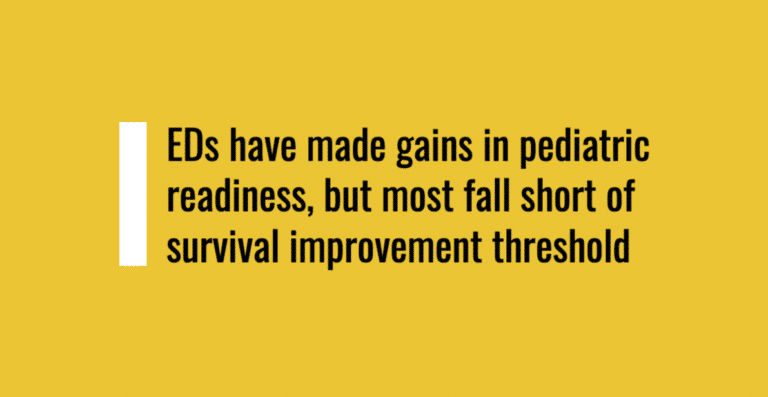Emergency departments (EDs) have made progress on pediatric readiness over the last 8 years, according to a new study published in JAMA Network Open. However, most EDs do not fully meet national guidelines for pediatric emergency care. In fact, the median pediatric readiness score falls well below the minimum score associated with marked improvements in survival.
These results indicate a significant improvement opportunity for all ED and trauma leaders. The American College of Surgeons (ACS) requires all trauma centers to perform a pediatric readiness assessment of the ED and have a plan in place to address any identified gaps (Standard 5.10).
Median readiness score shows overall gap
The findings of the new study are based on a 2021 reassessment of EDs by the National Pediatric Readiness Project (NPRP), led by the Emergency Medical Services for Children (EMSC) Program in partnership with the American Academy of Pediatrics, the American College of Emergency Physicians and the Emergency Nurses Association.
The assessment evaluates EDs on a 100-point scale. In the reassessment, 5,150 EDs were surveyed, with 3,647 responding and 3,557 available for full analysis.
The median pediatric readiness score in 2021 was 69.5. According to an EMSC press release, this score falls below 88, the minimum score associated with marked improvements in survival. (A 2019 study tied higher pediatric readiness to four-fold lower mortality in critically ill children.)
However, progress was made in 5 of 6 domains
According to the authors, the results of the reassessment largely indicate progress from the last assessment in 2013, which was based on earlier guidelines.
“Comparing commonalities between the two assessments, we see improvement in five of six categories,” said Kate Remick, MD, the study’s lead author and co-director of the NPRP. “This is especially positive given EDs were navigating the pandemic at the time of the survey.”
But researchers say COVID-19 did contribute to a decline in one pivotal category: designating a nurse and/or physician — ideally both — as pediatric emergency care coordinators (PECCs). EDs reporting both physician and nurse PECCs decreased to 28.5% in 2021, a 13.5% drop.
 “PECCs are a key driver of pediatric readiness,” said Hilary Hewes, MD, study co-author. “Unfortunately, the pandemic worsened widespread workforce shortages. Many EDs didn’t have resources to sustain the PECC role.”
“PECCs are a key driver of pediatric readiness,” said Hilary Hewes, MD, study co-author. “Unfortunately, the pandemic worsened widespread workforce shortages. Many EDs didn’t have resources to sustain the PECC role.”
As a result of the decline in this heavily weighted category, when comparing only common data points, researchers say there was a slight decrease — 1.6 points — in adjusted median scores.
“The decrease is minor given the unique circumstances of COVID-19,” said Marianne Gausche-Hill, MD, study co-author and NPRP co-director. “The improvement in five of six categories despite these circumstances is most notable, reflecting high engagement of providers over the last eight years.”
3 priorities for improvement
To improve readiness, researchers emphasize the importance of designating PECCs. Implementing pediatric-specific quality improvement plans and staffing with board-certified emergency medicine physicians are also associated with score increases.
“We hope all EDs, regardless of volume, will prioritize these three components of pediatric readiness,” Dr. Gausche-Hill said. “The association of pediatric readiness with improved survival makes it a health care imperative.”
To learn more about pediatric readiness, visit www.pediatricreadiness.org. To access the ED pediatric readiness assessment, visit www.pedsready.org.

